Marathon in the Chinese Far-West, Book 8
Taipei – Beijing (A333 - Air China) The Great Wall from the sky in French here in English there
Beijing – Urumqi (B752 - China Southern) Beijing by night in French here in English there
Urumqi – Kashgar (E190 - China Southern) Invalid boarding pass in French here in English there
Hotan – Urumqi (B738 - Air China) Crossing the Taklamakan in French here in English there
Urumqi – Dunhuang (E190 - China Southern) Winglet story in the desert in French ) here in English there
Dunhuang – Urumqi (E190 - China Southern) Two days after the storm in French there in English there
Urumqi – Shanghai (A320 - Juneyao Airlines) Single aisle across China in French here in English there
Shanghai – Taipei (A343 - Air China) 675 km in a 343 in French there YOU ARE HERE
This FR begins in the subway of Shanghai, on the long Line 2 which links SHA to PVG which are on opposite sides of the urban area.

Shanghai’s subway is like any other Chinese subway : clean, fast, very cheap, modern because built recently in the world’s urban transportation time scale.

A small difference is that there is an X-ray check of the luggage at each entrance. It is systematic in Beijing and Shanghai, but there are Chinese cities where there is none, or where it is optional (i.e ; a guard may require to scan it). Since there is no security check of the passengers themselves, I once simply put in my pocket a kitchen knife which I was forbidden to have in my bag when entering the subway in Beijing. This daily small waste of time always annoyed me.

The security check above is not that of the subway, but of the Maglev, because I bought myself this treat for a few euros. For future users, note that if you produce the paper copy of an incoming or departing flight of the same day, you get a 20% rebate off the standard 50 RMB fare.
Shanghai’s Maglev is the example which should be shown to all students of the transportation system that engineers should never have designed, that salesmen should never have sold and that politicians should never have bought.

It does work, magnificently : it is high tech technical marvel, but it is an economic disaster. Germany’s Thyssen never managed to sell it at home, neither for the Hannover-Berlin line, nor for the MUC – city center line, and the Japanese, who developed a similar (but technically different) prototype have not yet officially abandoned the option of selecting it for the future new Tokyo – Osaka line, but it hardly makes a difference.
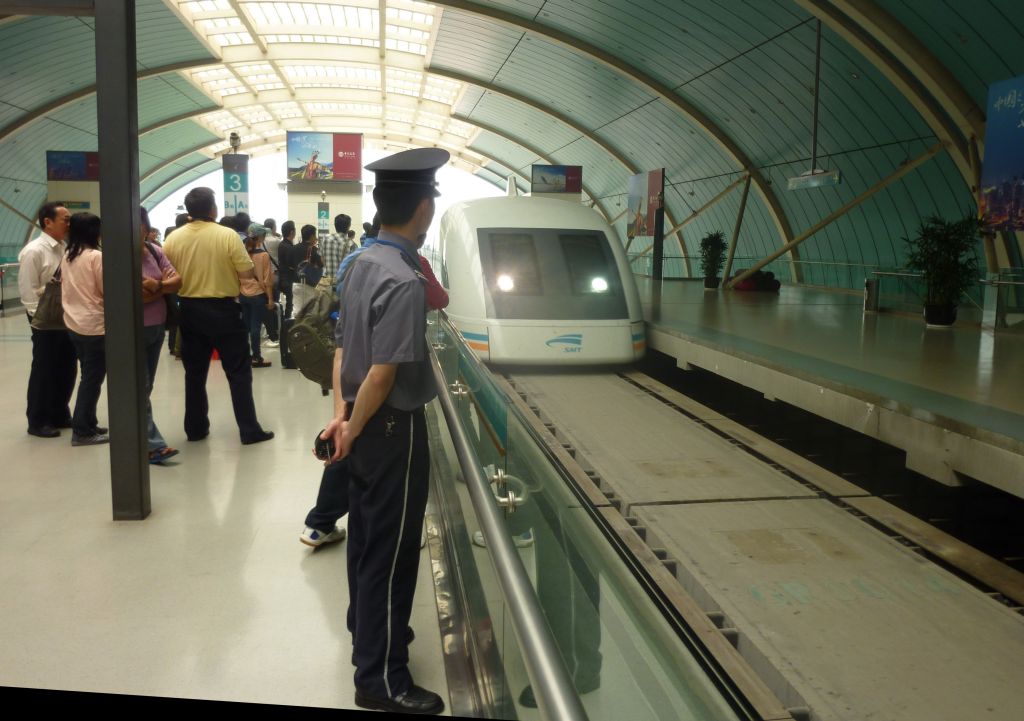
Too expensive to built, to operate and to maintain, incompatible with any other system: this 20th century toy is doomed, and this picture sums it all : its future is a dead end.
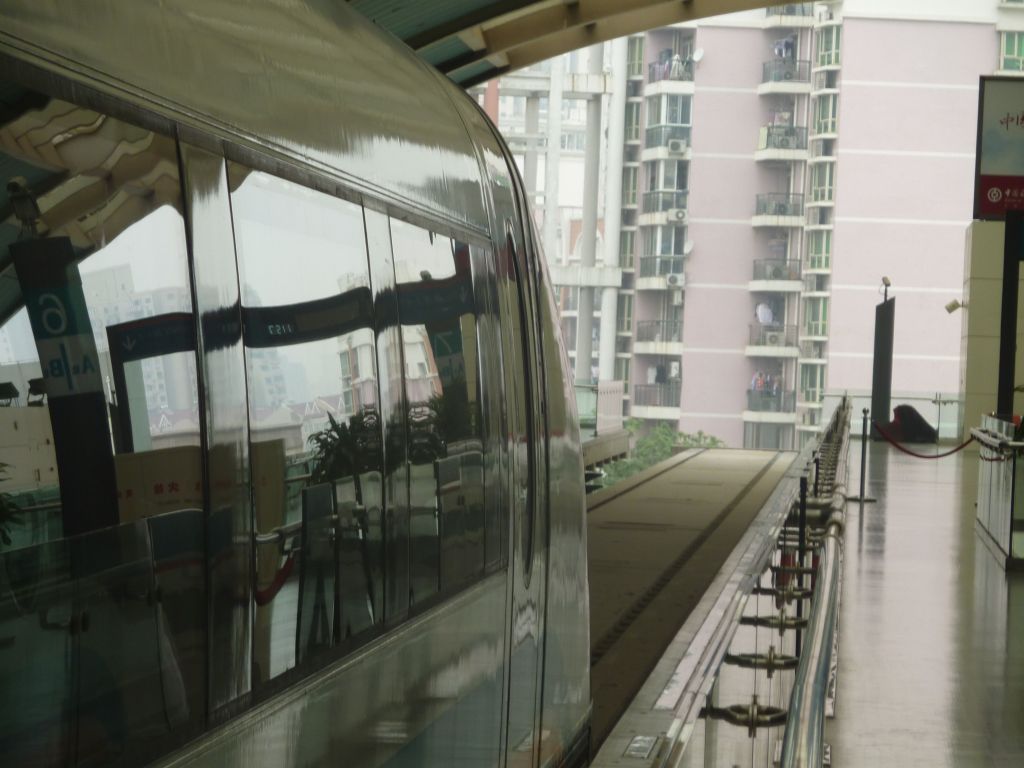
You should be extremely careful when reading previsions of extension to SHA, which would provide a 20 minute SHA-PVG link, and the project of a line to Hangzhou is quasi abandoned.
To top it all, at peak traffic times, it takes 8’20” instead of 7’30” from end to end, travelling at a mere 301 km/h like any European high speed train (and slower than many), and I have not even be beaten my speed record in a land vehicle.

In the middle of the day, the patronage is dismal: the load ratio was barely 15% of the seating capacity.
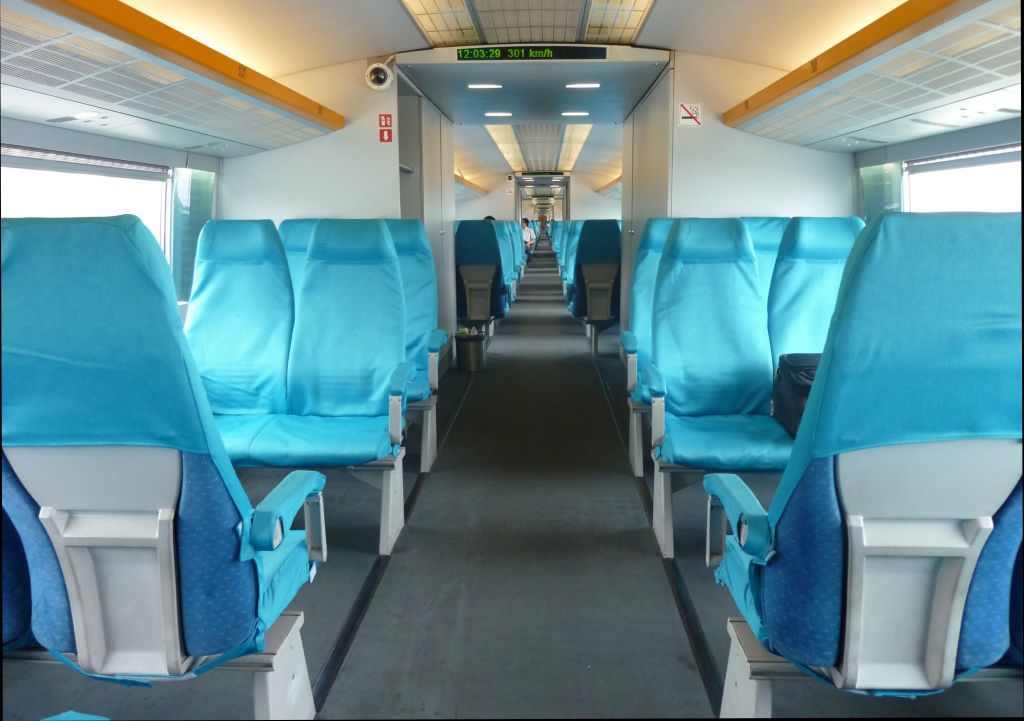
Arrival at the other end station, located between both terminals.
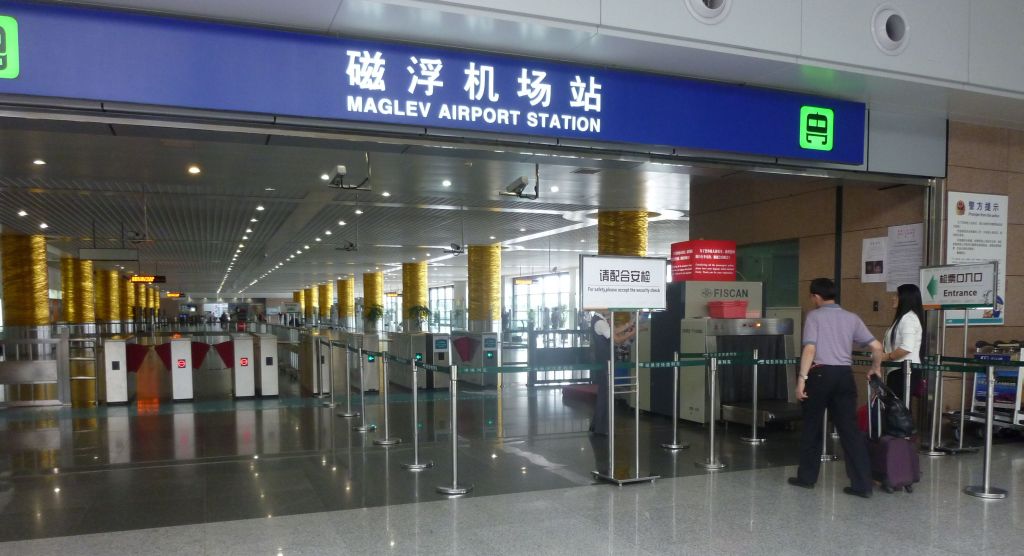
Bothe terminals are wide and well lit

There is a reasonable line at the check-in counters of Air China’ international flights, but the bad news is that an employee on the left comes and asks each passenger for his destination: “Taipei? The check-in is delayed, please come back half an hour later”, with no further information.

Half an hour later, there was nearly waiting at the counters: “The plane has a technical problem; we do not know yet if it needs to be replaced, please come back another half hour later”.
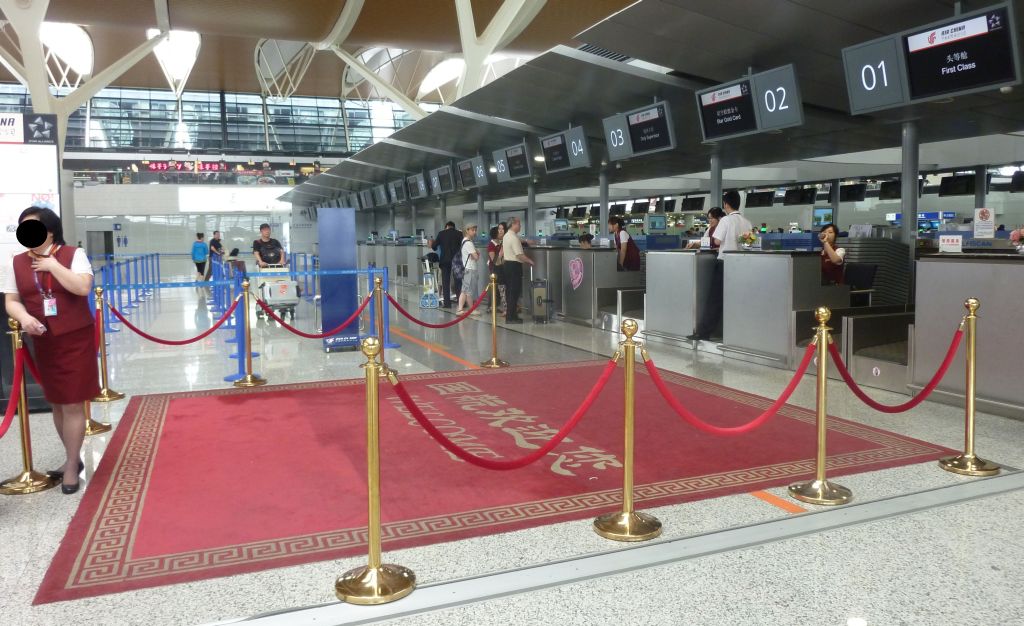
The situation becomes clear: the back-up plane is probably a different type, with a different seat layout, and checking in passengers prematurely could complicate matters.

Meanwhile, I take a picture of these two hotels located between the terminals, but I do not stay outside very long, because Shanghai’s hot and humid weather is quite uncomfortable.

I had no problem finding a seat, without a power plug (I know that the only ones landside are at one end of the terminal), and I continue writing FRs, quite unhappy of wasting here the hour that I expected to use for plane spotting.

The flight to Taipei is still listed as departing at 14h35, with no specific indication.
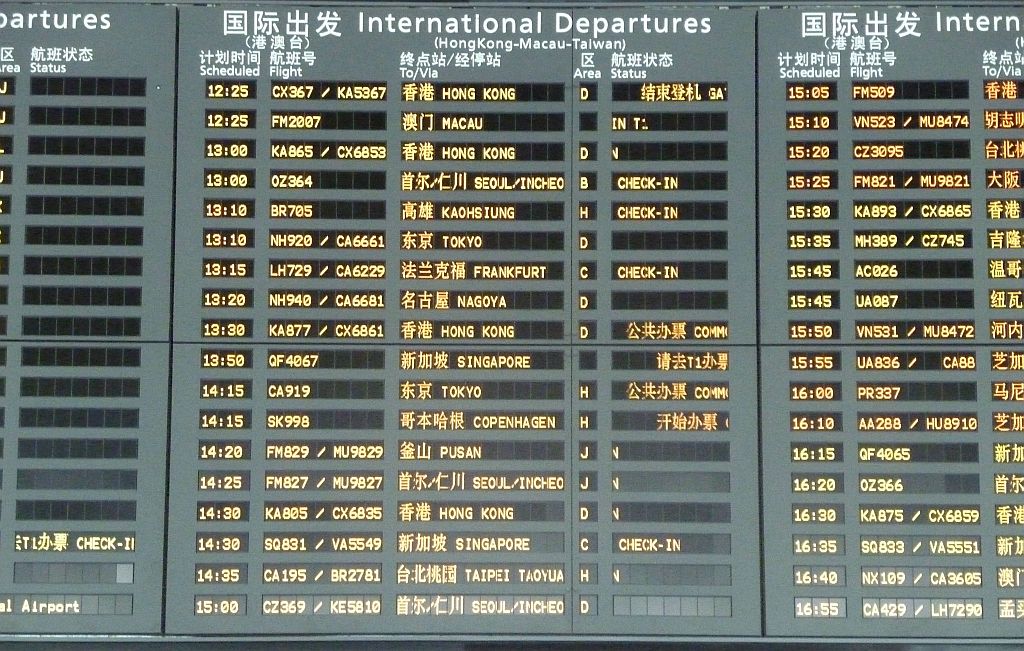
An hour after arriving in the terminal, I come to the counter, where checking in of Flight CA195 has started at last. A miracle: there is a window seat left, at the next to last row of the aircraft. No problem: the last window seat is better for me than the first aisle seat.


Next, the safety and immigration control where the lines are longish. For newcomers on Flight Report, this picture reminds newcomers on Flight Report that since Hong-Kong and Macau have returned to China, but with a 50 year very special status, and since China keeps claiming that Taiwan is part of its territory, these three entities are never included in the “international” denomination in China. The three small ideograms on the right (Xiang-Ao-Tai) are short for Xianggang, Aomen, Taiwan, i.e. HK, Macao, Taiwan, in Mandarin Chinese.

After wasting all that time to make it airside, I have a grossly insufficient time left for serious plane spotting, even more so that we are transferred by bus, which makes me guess that Air China selected the back-up plane option.


777 SQ in Star Alliance livery, departing for Singapore, of course.

Furthermore, the weather is as very often in Shanghai extremely hazy. This Juneyao A320, a reminder of my previously flight was at the extreme limit of the visibility range.

Etihad A330, from the lower level boarding room.

The boarding room. Even thought the flight is displayed as “boarding”, there is not much activity – another cause for frustration, because I wish I had stayed longer upstairs spotting planes.
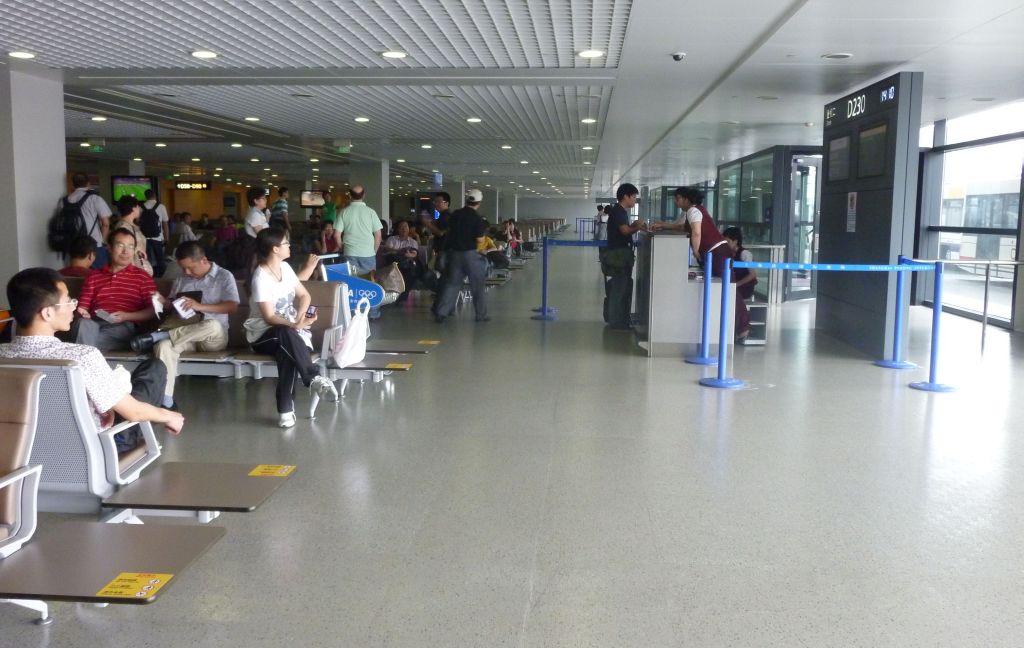
A picture of the waiting bus, because I have little else to do.

In China, all airside vehicles have a specific registration plate, with a green background; the last two ideograms mean “Civil Aviation”.

A JAL 767 passes by in the distance

It is 14:35, the flight is still announced as “boarding”, and my educated guess is that it will not take off at 14:35 as scheduled.
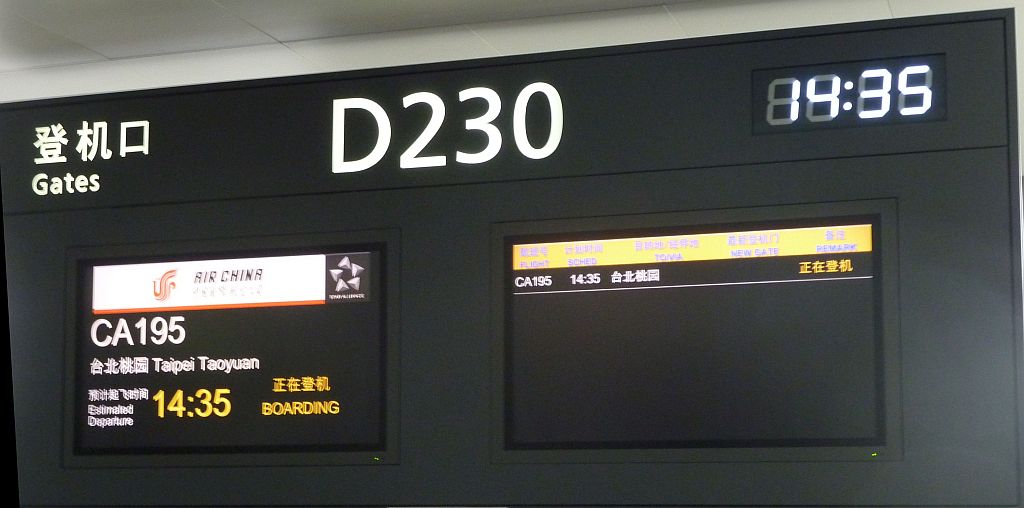
We board at long last the bus, which will provide me with some plane spotting opportunities, very few actually, because it is a short distance to the plane.
A Shanghai Airlines 737
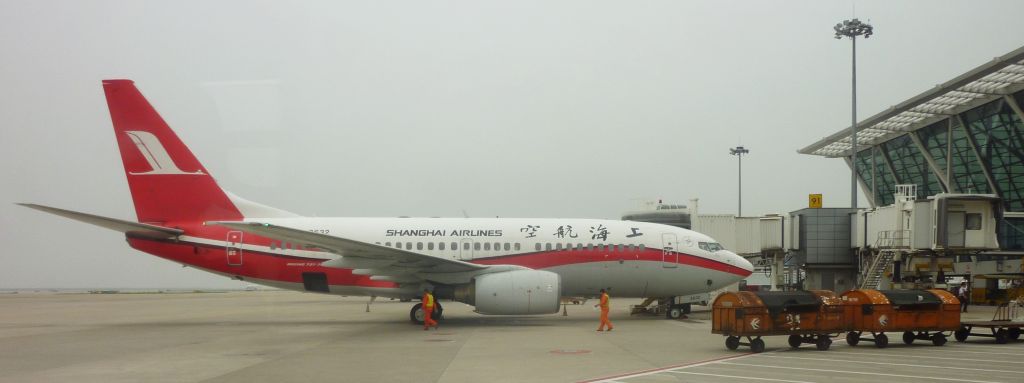
The same, in front of a Shenzhen Airlines 320

The J / Elite passengers are brought by a minibus (with the same green number plates)
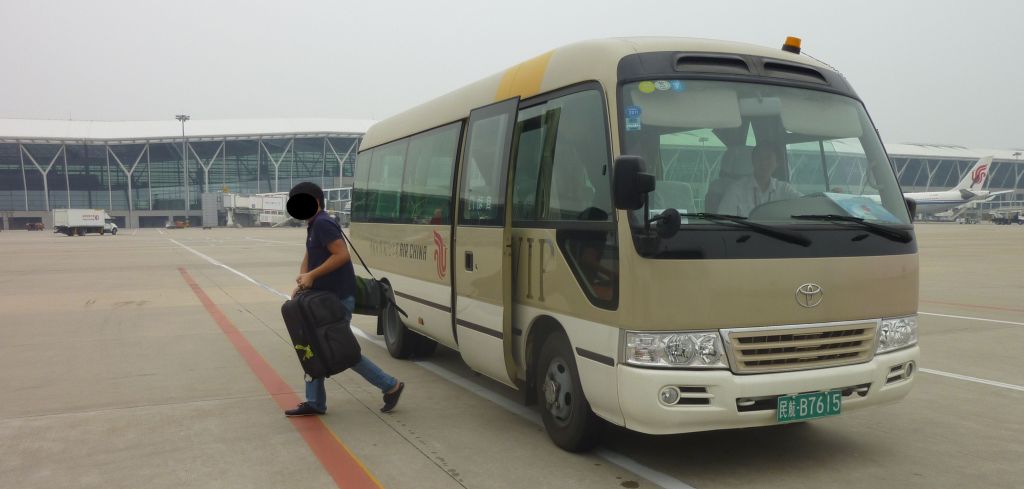
The major plus of reaching a plane by bus, unless the weather is too rainy, is that it provides a wide range of views of the aircraft, especially when many passengers are boarding, which takes (and gives) time. This is all the more interesting that an A340 is the kind of aircraft which is often pier-side. The plane is too big, or the bus stopped to close to hope having it all in a single picture.
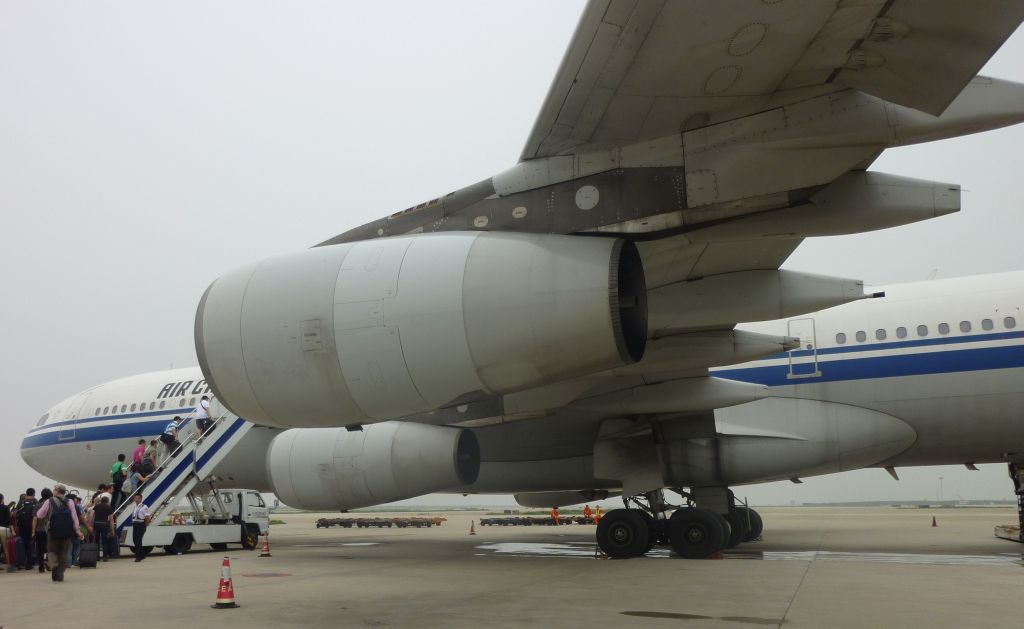
I do not really like this view, but it shows the logo on the winglet and the plane registration number, which some appear to consider mandatory for an acceptable FR.
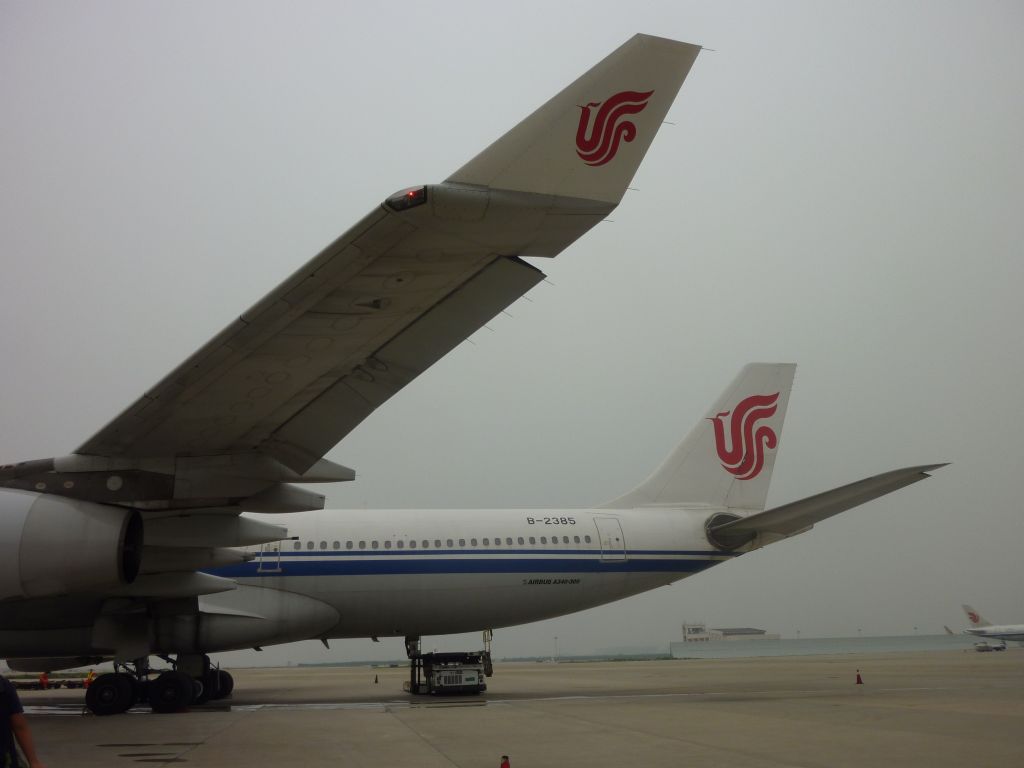
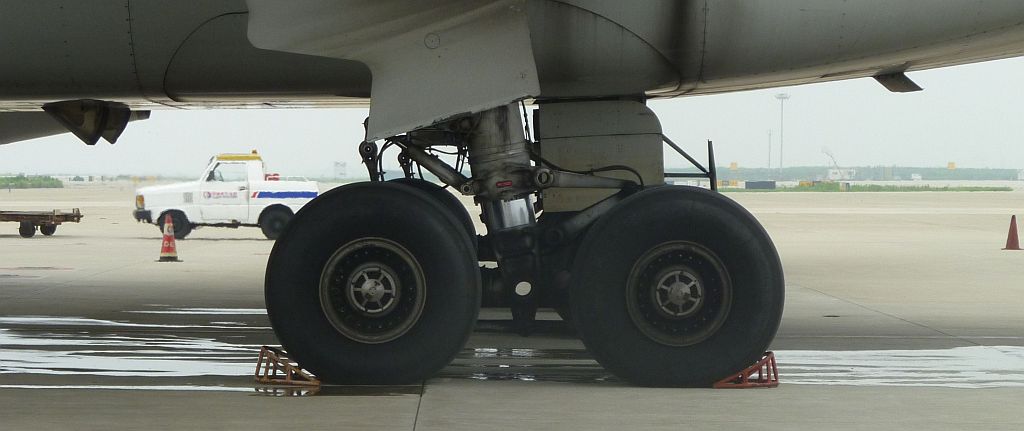
I know that there are lovers of the gigantic GE90, but I prefer the “too small” reactors of the A340. They seem like toys, compared to the size of the plane.



This picture is dedicated to all the Flight Reporters who have been reprimanded for a picture taken on a tarmac anywhere in the world. I guess that the ground staff would intervene if the passengers strayed too far away from the direct line from bus to aircraft, and I could not realistically move back far enough to have a picture of the entire 343 in a single shot. But apart from that, there was total freedom to fill my memory card.

The same picture after moving away from the ground staff.

Not only do I have the registration number of the plane, but also that of the stairs, which is seldom mentioned in flight reports.
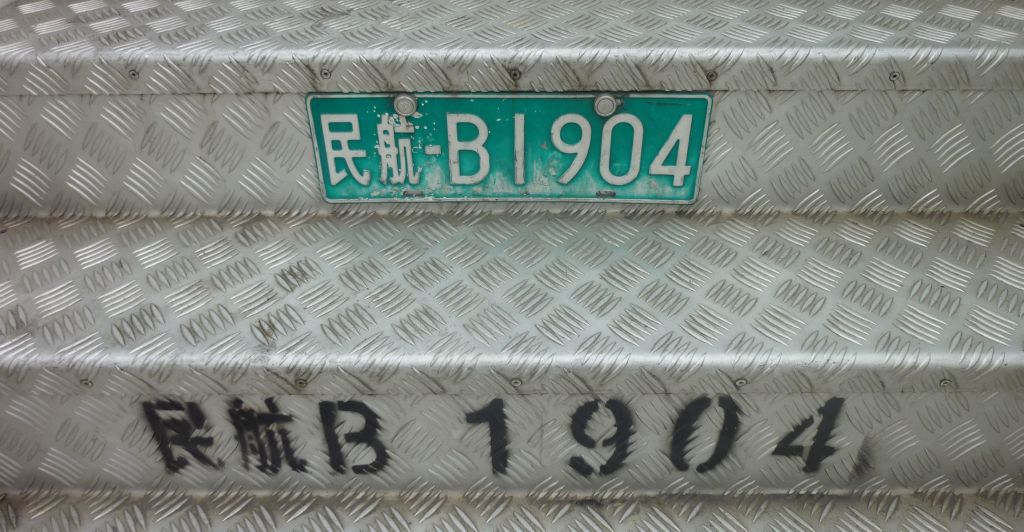
A front view of a reactor, halfway up the stairs

There is a story behind this picture taken from the top of the stairs. I had left on vacation with two cameras. The first one died on the very first day, and the second one started having problems halfway through our trip, with the zoom seizing if it was not very gently helped back into folded position (sand is never good for mechanical devices). When that happened, it took two to three minutes of tricky maneuvers to get the camera back into working condition. It happened just there, when I was the last one on the stairs, with an inoperable camera at the worst moment. A flight attendant came to me:
- What happens?
-I apologize, my camera has a problem, it will take me two to three minutes to get it to work again, I wanted to take one last picture.
- Please, take your time
The dialogue was actually in Chinese, but I know a number of companies where the flight attendants would have told me in whatever language to please board now, even though another passenger bus was yet to come. This dialogue earns Air China a bonus point for the crew rating.

Take me time to enter the plane provided me a good view of the second business cabin.



This will be my environment for a 675km flight, i.e; 5% of the range of a 343. There is some space left of the seat, which makes it wider, and the last rows are in 2-3-2 layout.
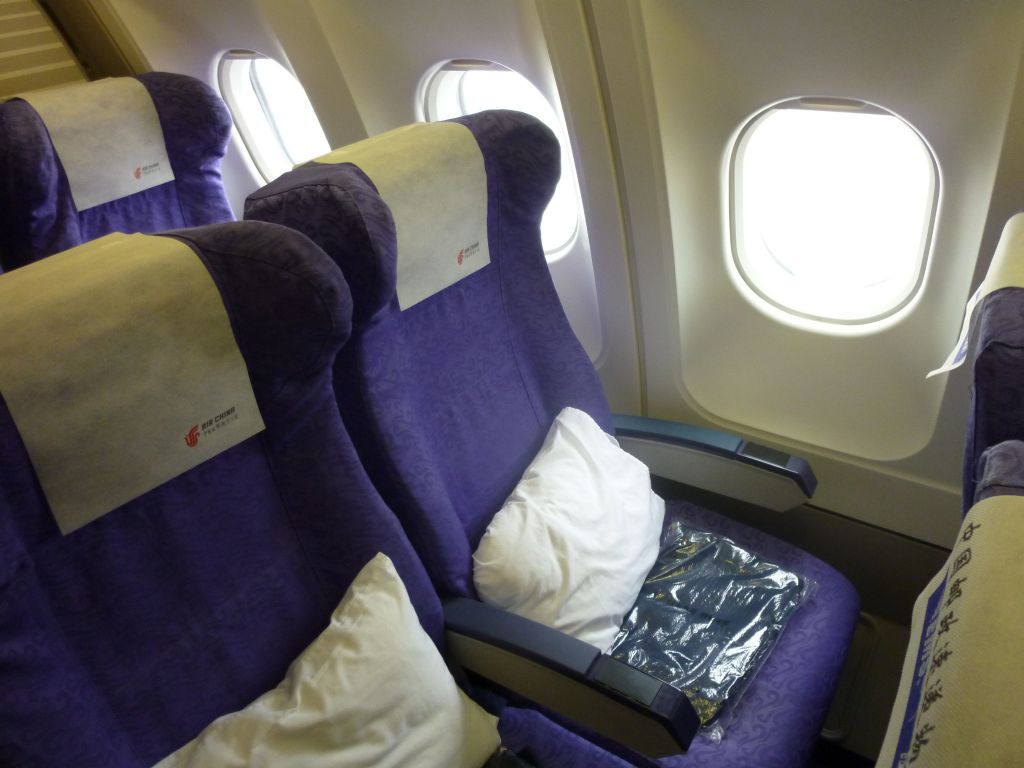
On the other hand, the weather does not improve. I barely manage to take a picture of the LH 343 which is going home.
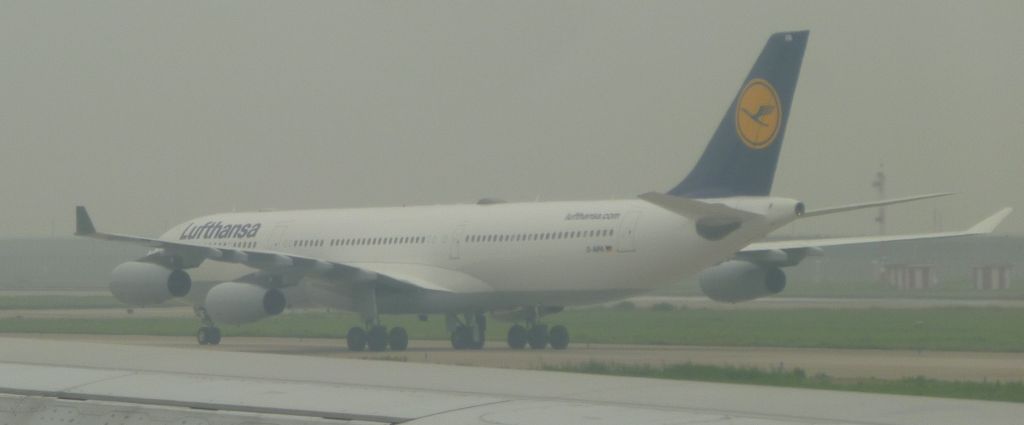
And the terminal disappearing in the haze far away

The economy cabin from my seat, with the bald head of a foreigner sticking out at the row before mine.

The seat pitch is very decent
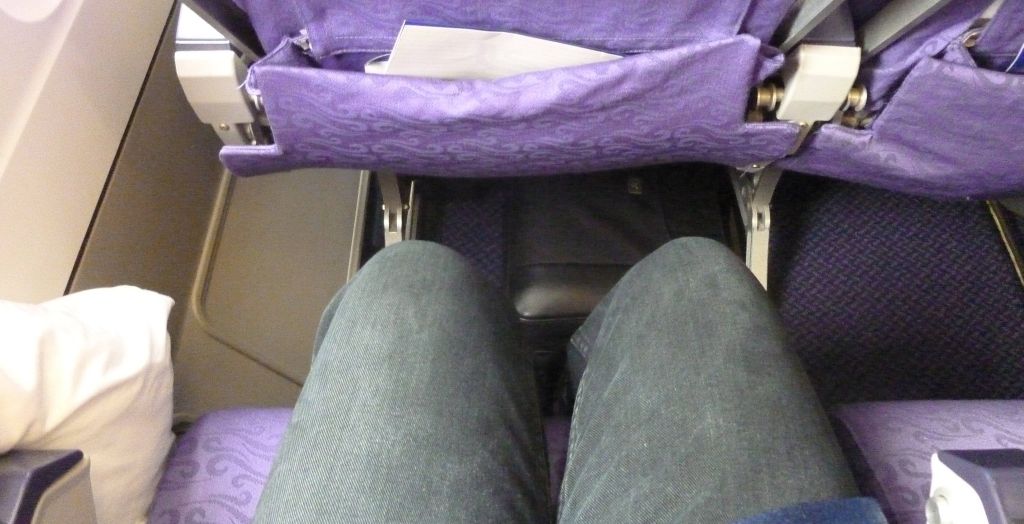
A flight attendant distributes Taiwanese immigration forms that few people take, because the Taiwanese and Chinese do not need them, and neither do the foreign residents. This is an example of a forbidden picture: taken from far away with a telelens, and bad luck, a flight attendant who happened to come behind me saw the screen and scolded me. Not aggressively, though: this was not a case of a “show me that you delete this picture” (I had that with Chinese soldiers).

I processed the pictures to improve the contrast and colors of this unusual double tail aircraft from the Persian Gulf.

… which splits to reveal an EK 388 taxiing on a parallel taxiway.
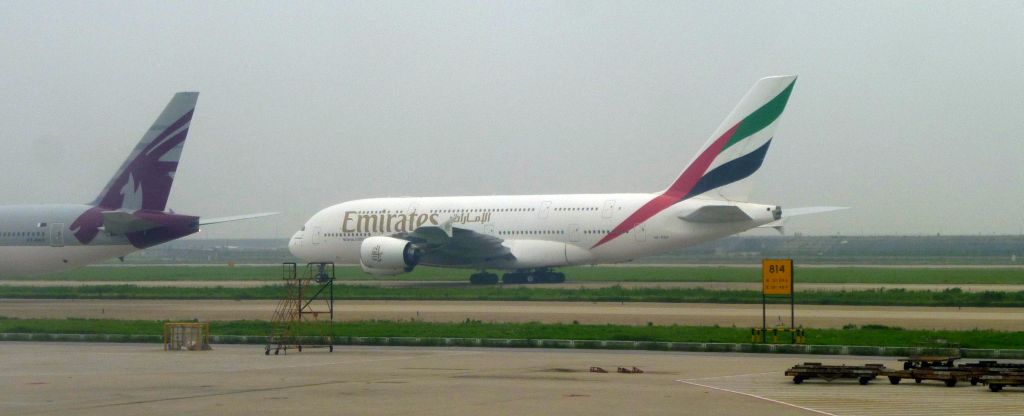
There it is pier side, with its original colors.

In the distance, and hardly visible with such a poor visibility, a Siberian Airlines (S7) aircraft.

Landing of a Dragonair A321,and take-off for us


The IFEs of this 343 in regional configuration provide minimal service.
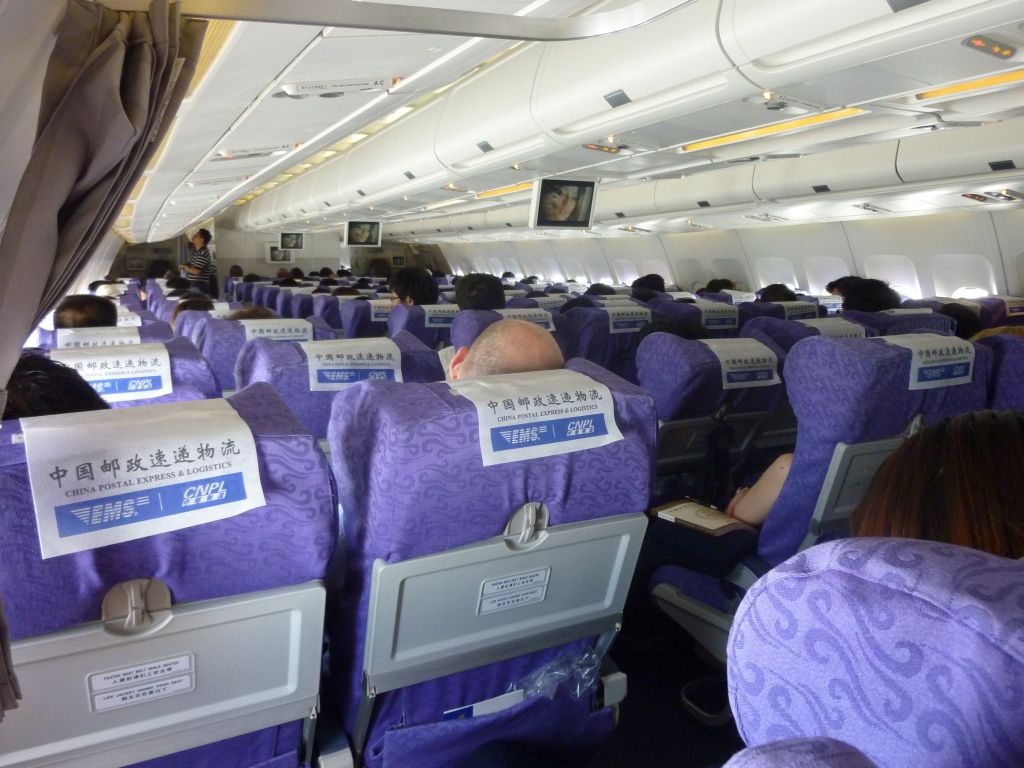
The usual safety card

The meal comes with a decent coffee, and - guess what – a dried pork and cucumber sandwich! Do you realize what this means?
No? OK, I’ll have to play it didactic, before I lose my readership

This pork and cucumber sandwich! You need to have lived in Taiwan to understand. You cannot have anything more typically, deliciously, exclusively Taiwanese than cucumber pork. I never saw that in China or elsewhere in the world, but you can buy that in any grocery store in Taipei and elsewhere. Eating a pork cucumber sandwich in the plane is already being in Taiwan, after two weeks in the other China. Liking pork cucumber is being part of the club. This deserves one food bonus point.

PS : if you have not lived in Taiwan, it is a stuffy sandwich that makes you regret not having a bottle of water to wash it down, and would be rated one full food demerit. No wonder my Mainland Chinese neighbor did not want it, so that I could savor a second one.
The weather cleared up over the Pacific, where there is not much to see.
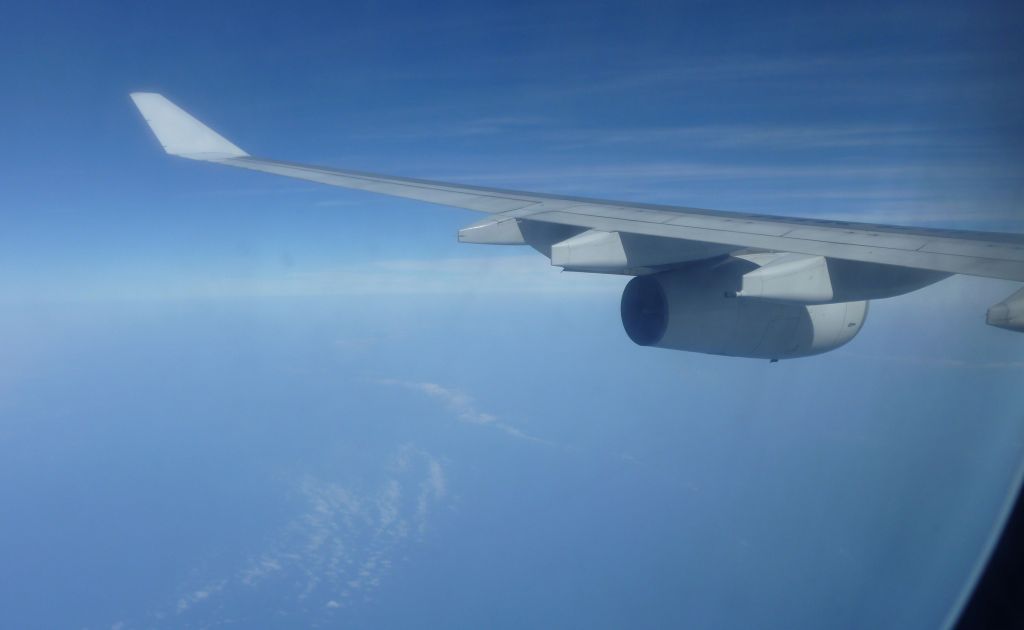
A good thing that the decoration of the winglets are not rated in FR, because that of Air China is worthless.

[Taiwan Tourist Office mode ON] Taiwan was shrouded by these enchanting mists which charmed the Portuguese explorers who named it Formosa (“Beautiful”), and artists who painted and wrote their admiration for centuries, on this hot day announcing the summer pleasures [OFF]
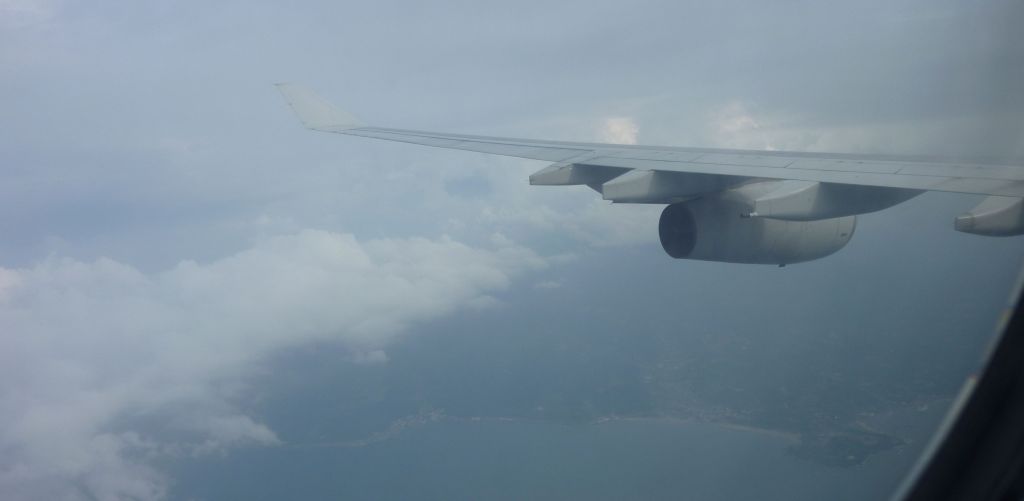
Actually, it was the beginning of a week of rotten weather that only the Taiwanese can create. It fell cats and dogs during Monday night (900mm in 24 hours in the south, try to imagine that !), roads and railroads were cut off including in the vicinity of TPE, with landsides, the real thing. In Taipei, the waterproofs gates of the levees were closed, and the government ordered all schools and companies to shut down on Tuesday afternoon.

The Xindian river in normal weather, flooding on the right
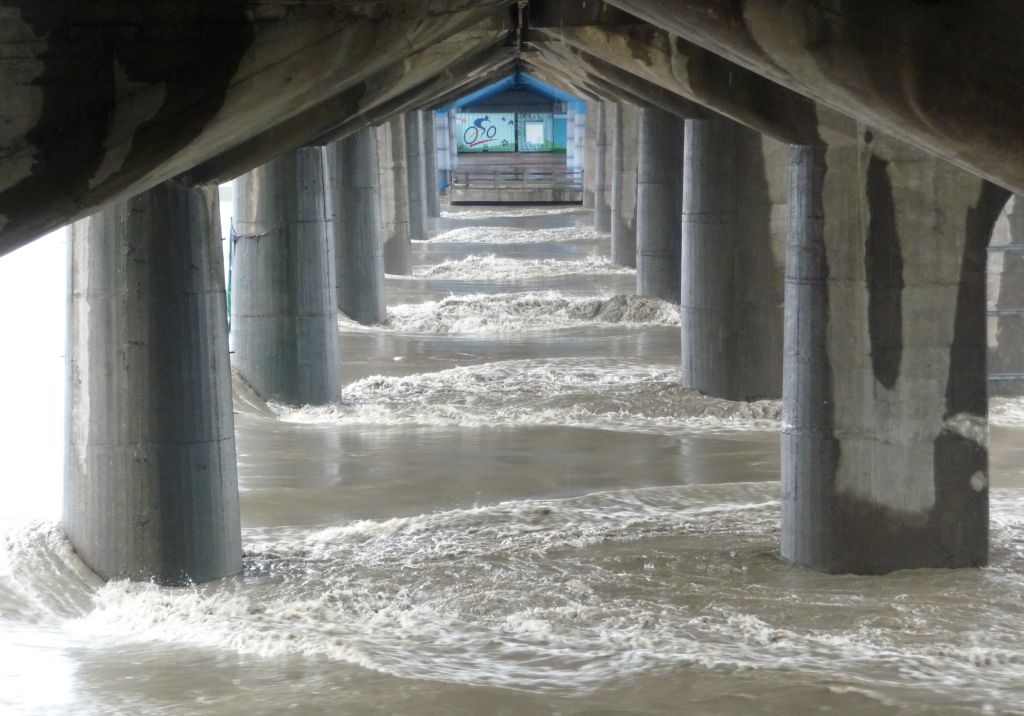
The muddy flow of water under the Sun Yat-sen bridge
It was a good idea to land one day earlier, and this is the north coast of Taiwan.
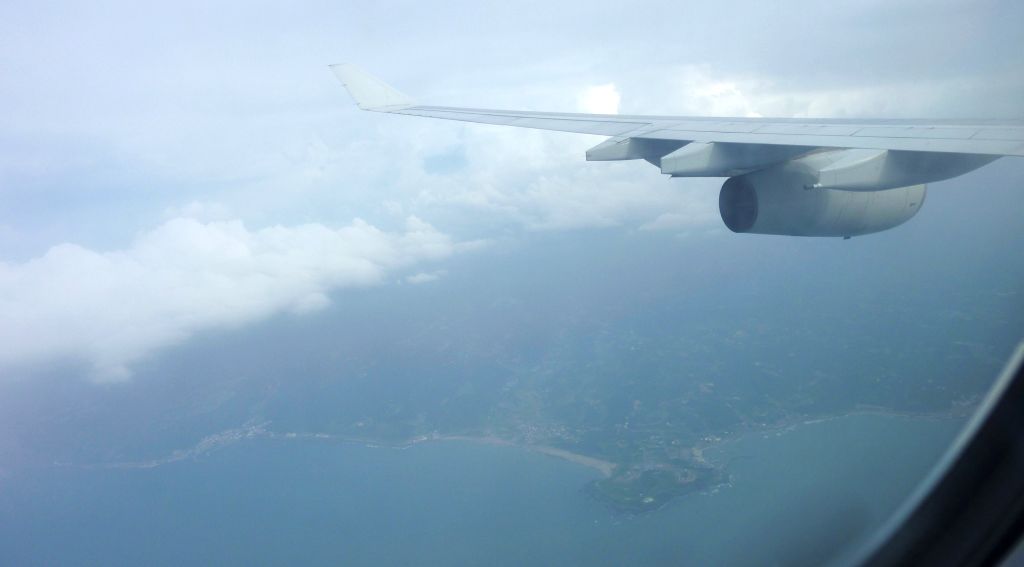
I tried to improve the legibility of the pictures, with limited success

This one was really easy to identify for me: the estuary of the Danshui river, 25km downstream from Taipei.
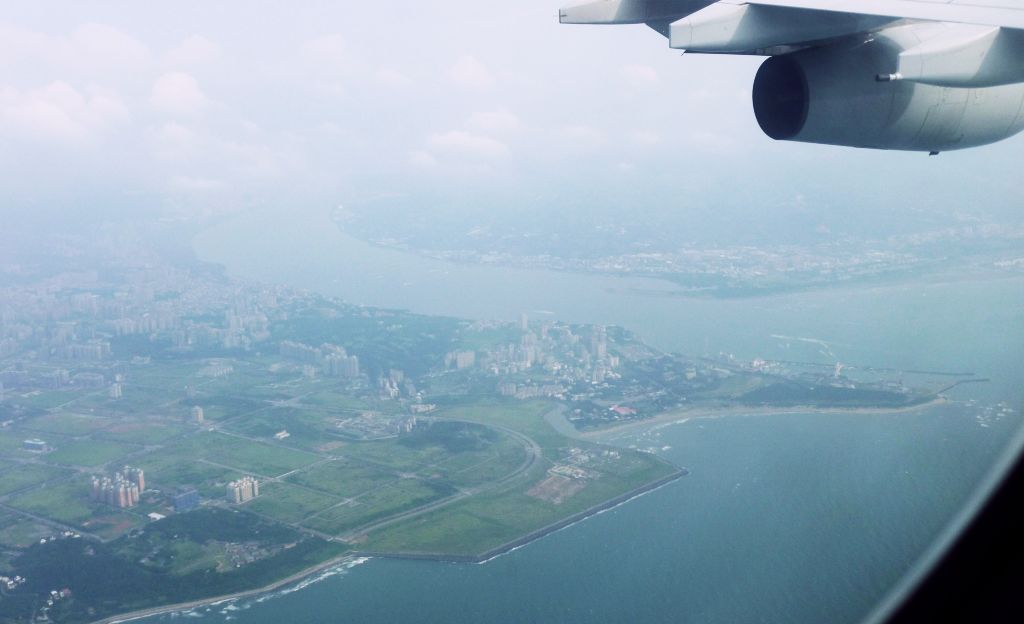
This is the small Danshui town, the end of a subway line. There is an interesting collection of historic building there, maybe not very impressive, but having had a major role in the history of Taiwan.

The very photogenic harbor of Danshui, with the arch of the Lovers’ Bridge


The same, from the ground

In the background, you cannot see Taipei which is behind the curve of the river, but on the opposite bank, you have Bali… not the Indonesian island!
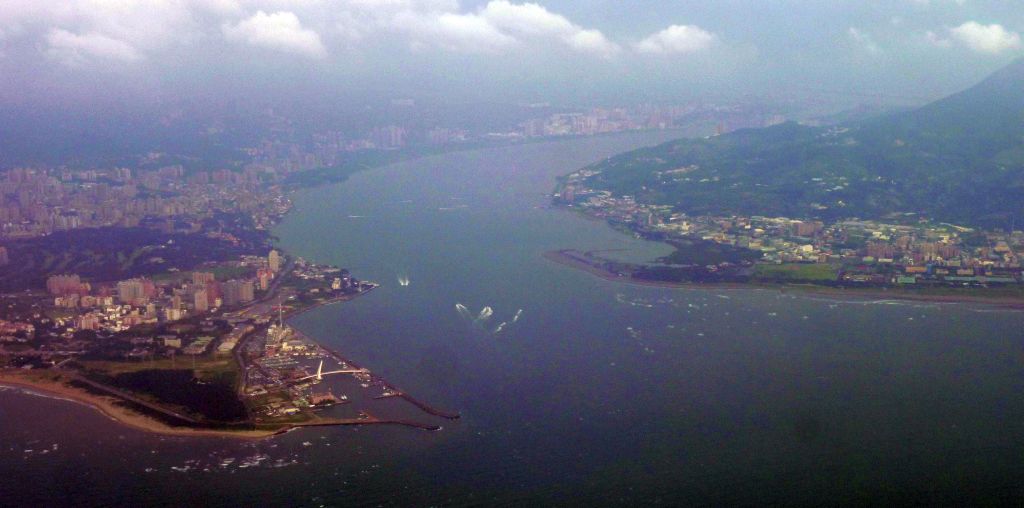
The beaches of my Bali are definitely not as good as those that you could think of when reading this name, I enjoyed cycling all the way to there on 30km of cycling lanes completely separated from any motorized traffic, five minutes away from my home in Taipei. This is the last bridge on the Danshui; note the sign top right.

Let’s go back in the air: Taiwan’s Bali is actually much less of a beach paradise than the other one, because apart from an interesting archeological museum, it mostly boasts an industrial harbor, beyond the beaches next to the river end.

There are three times as many windmills as fuel power station here. It does not mean that three quarters of the energy is eco-friendly.

I do not know what this infrastructure could be. I imagine something like a military training ground.
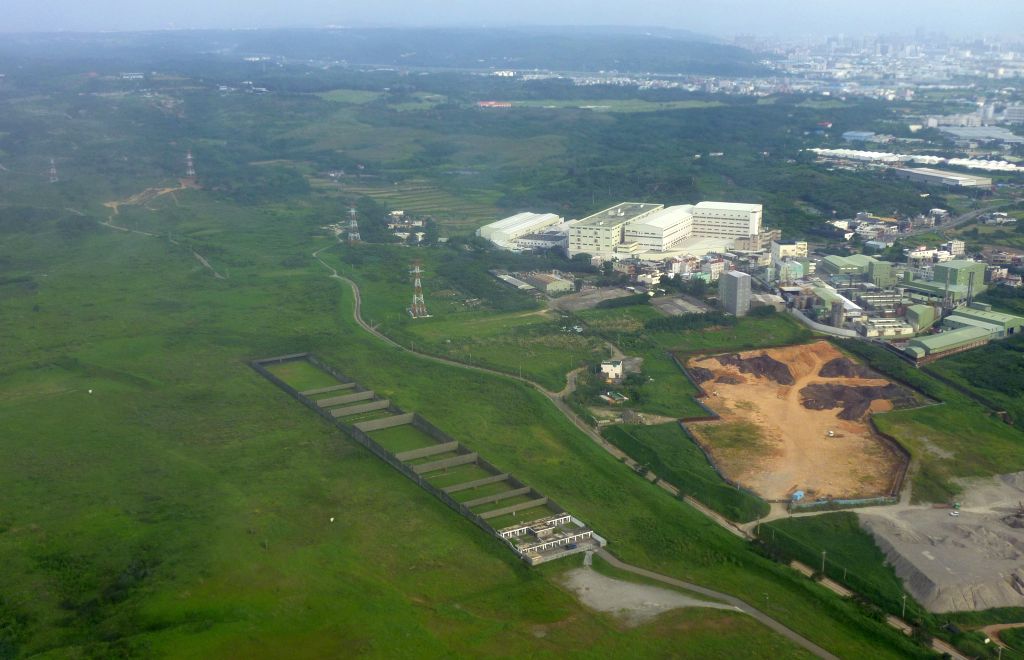
Landing is imminent

I already saw before this Shanghai Expo 2010 MU A330; they could change the decoration two years after the end of the event.

Arrival pier side among China Airlines aircraft

No doubt about it: I am back in Taiwan.

I was puzzled by this completely white 747, but I could not get a better picture.

The Y and J cabins, upon leaving the aircraft.


Meanwhile, an SQ 333 has arrived at the next gate, seen here through tinted glass.

We go through duty-free areas: this is the last moment for buying illegal wares which are illegal (for minors), immoral (when you burn them next to somebody) and fattening (for chocolate addicts).
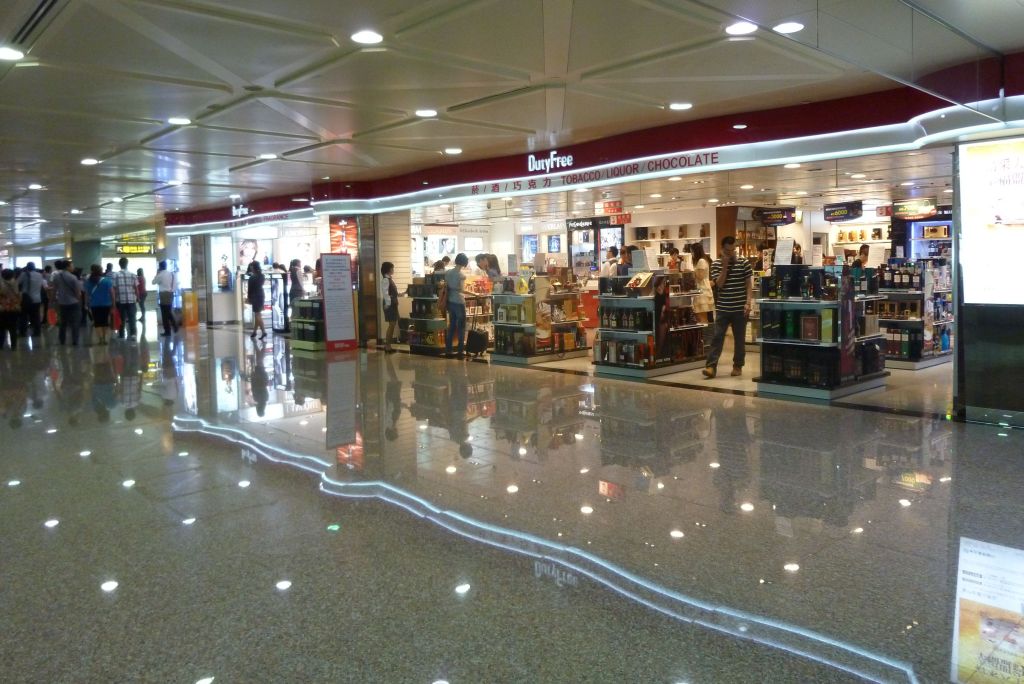
The list of arriving flights

Exit of a BR crew
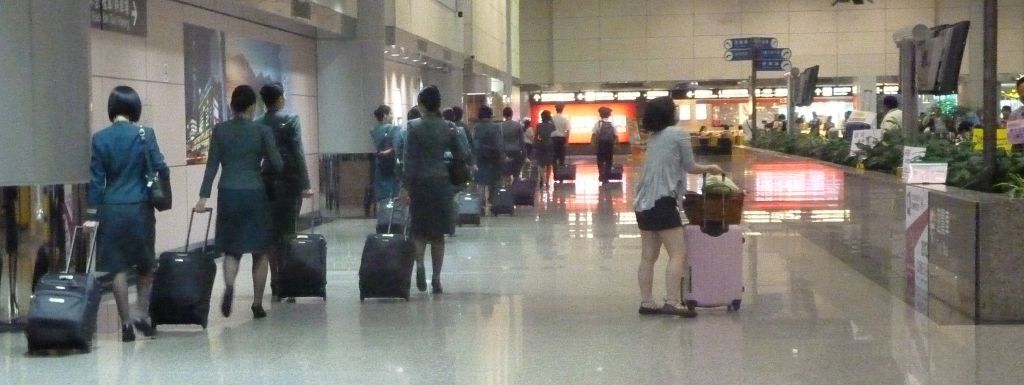
Many Taiwanese wait landside for passengers

But nobody is waiting for me, and I go and wait for bus 1819, which is semi-direct to Taipei’s central station.

I am no more that half an hour from my apartment and the access to the free world internet: this is not the corporate screen, but the draft of my FR on flight HO1216.

The bus drops me in front of the central station and of the undistinguished Shin Kong building, which was Taipei’s tallest building until the Taipei 101 tower was built.
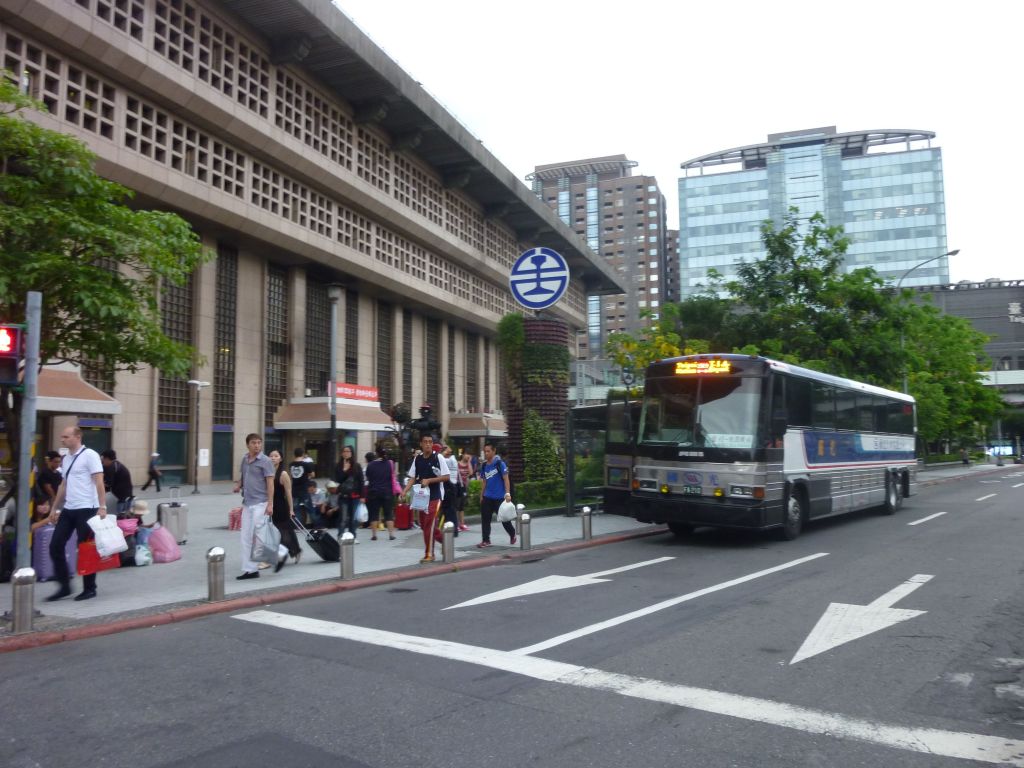

Epilogue
This collection of luggage tags (something missing in Flight Reports) sums up a vacation in a region unlike any other in Mainland China, even if taken one at a time, there are deserts, Muslims, non Chinese languages, camels, etc.. in other Chinese provinces.

This flight report was written at the time of the exams and finals in many countries in the world. This was my message for all Flight Reporter of students age, a picture taken in the center of Dunhuang, a stone throw from a high school at the time of the tests of the terrible gaokao, the nationwide university admission exam which in three days seals the professional future of the Chinese teenagers.
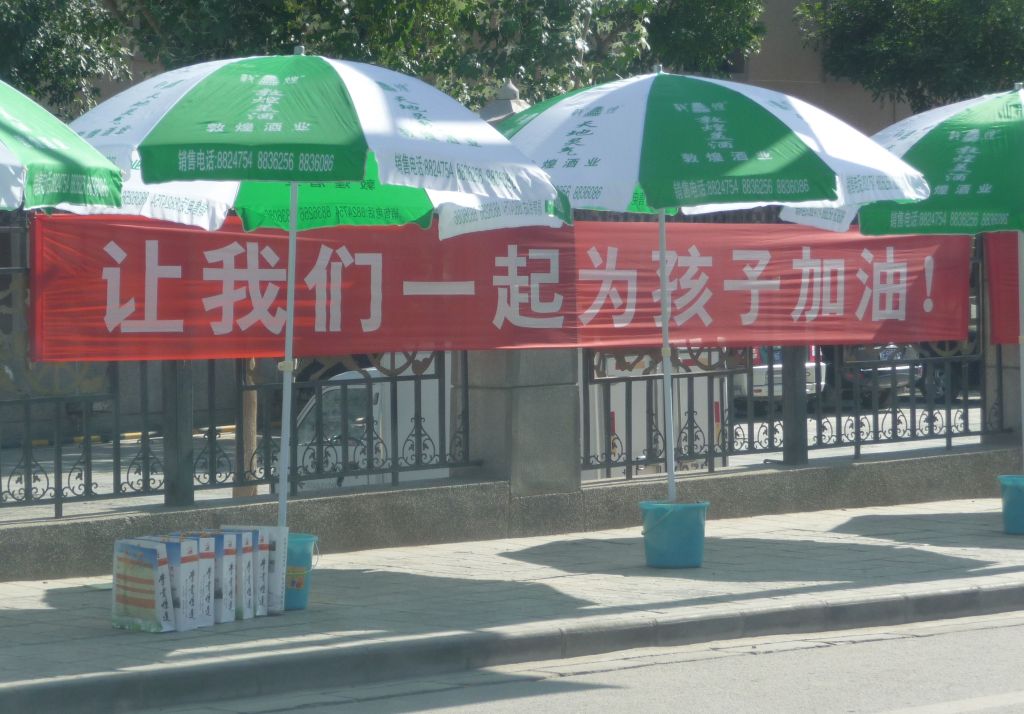
Good luck to the children from all of us!
The last ideograms mean “good luck”, which in mandarin is said jiayou, literally “add gas” (like press on the gas pedal to have more power). A gas station is a jiayou-zhan, a station where you add gas.
And last, a sunset in the desert again in Dunhuang, where this transmission tower recalls the modernization of this region of China, which remained for a long time stuck in the time of the Silk Road, for the better and sometimes for the worst.
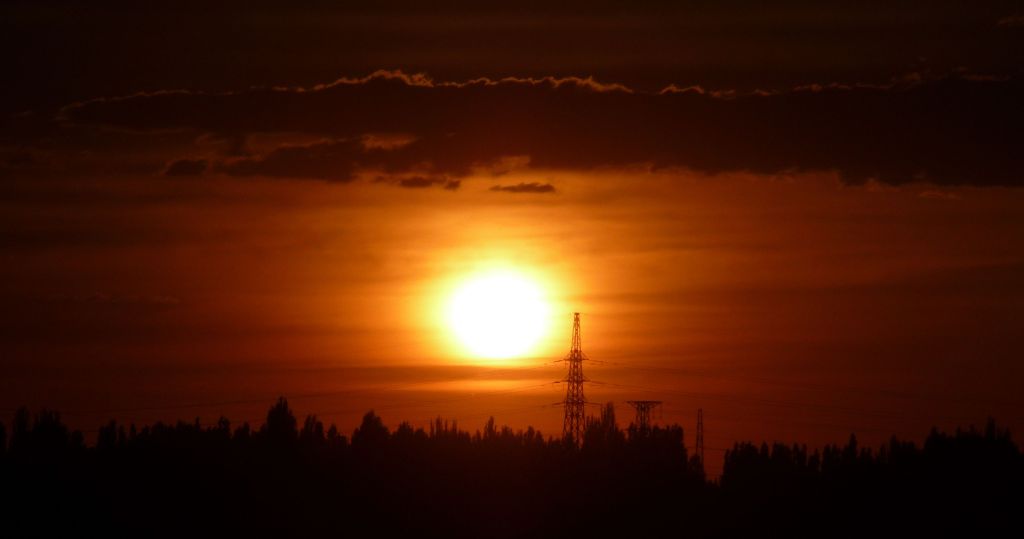



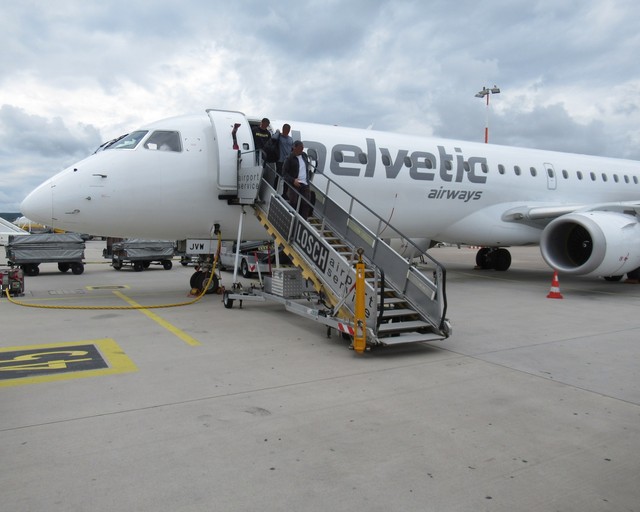

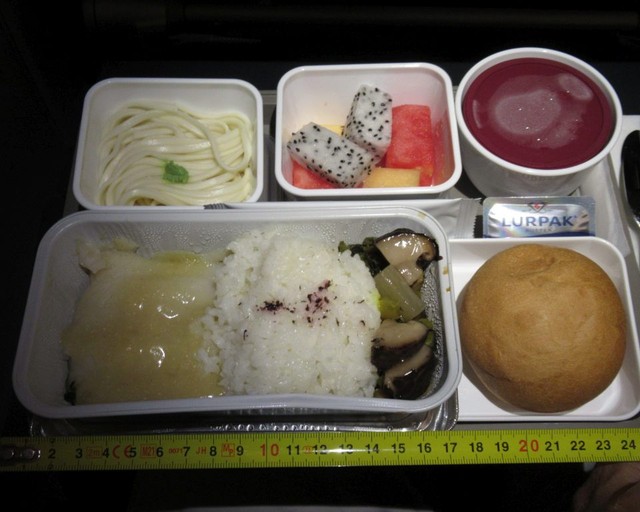

Thanks for the great report and pictures. Your last picture of the sunset is truly breathtaking. This flight would have been unthinkable a couple of decades ago. How times change.
History walks indeed at a brisk pace in this part of the world. In 2009, cross Strait flights were so few that I managed only once to secure a seat on a PEK-TPE direct round trip. My Taiwan tour book published in 2007 did not even mention the Kinmen-Xiamen ferry which I boarded several times in 2011. Thanks for your readership and comment !